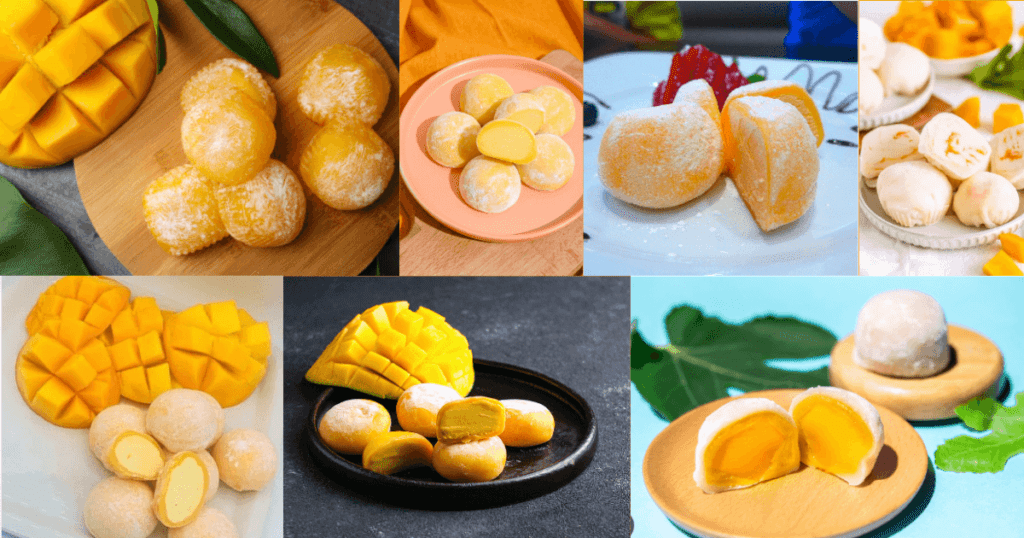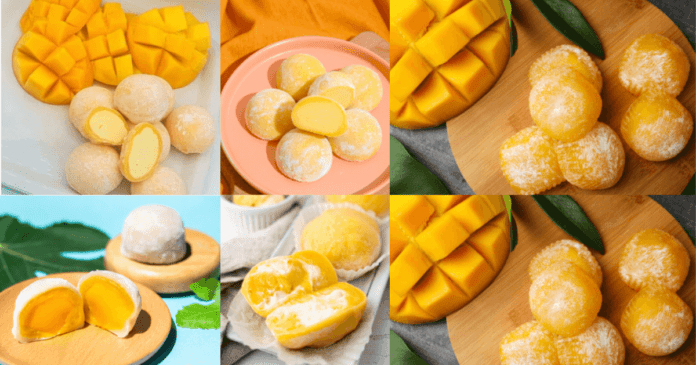Describe what a mochi is. Mochi Ice Cream If you’re not acquainted, mochi is a type of Japanese dessert called wagashi that is formed from sticky rice.
It’s typically pounded into a paste with water and eaten just that—uncooked, rolled with flavorings like roasted soybean powder, or filled with fillings like red bean paste.
Daifuku are mochi that have had a filling placed within. Any Japanese delicacy prepared with mochi and a sweet filling is referred to as daifuku.
The traditional Japanese mochi is a little different from this one. These are stuffed with ice cream instead!
The globe loves mochi ice cream, especially now that it has become more and more popular in the US. You can now prepare mochi ice cream in your kitchen!
Ingredients
With just two ingredients needed, this is one of the simplest meals you’ve ever made!
Mango Ice Cream
Since cream and thickeners are required to prepare the mochi, opt for mango ice cream instead of mango sorbet! You can use sorbet, but the mochi won’t be as soft.
Glutinous Rice Flour
These mochis are made from glutinous rice flour, also known as sweet rice flour! You may find sticky rice flour in a few distinct varieties.
The two most popular are the Thai Elephant brand, which is manufactured from long-grain glutinous rice, and mochiko, a Japanese short-grain glutinous rice flour.
Since I am aware that some countries may have trouble finding mochiko, the Thai brand is ideal for this recipe as well! The two brands won’t differ all that much from one another.
Remember that different varieties of glutinous rice flour absorb water in different ways. Consequently, depending on the type you use, your mochi may come out stickier or drier.
Read also: Vegan Strawberry Mochi Ice Cream

FAQ’S
What is the length of this?
Since the mochi skin may harden in the freezer the longer it is stored, these are best consumed within three days.
After they are prepared, they can still be eaten for up to two weeks!
Which is the best way to eat mochi ice cream?
Before you eat the mochi ice cream, make sure it has had some time to defrost. They will be extremely hard when they first come out of the freezer, but the skin should have softened to a deliciously chewy and soft texture after ten to fifteen minutes at room temperature.
Yet, what makes mango mochi so wet?
The mochi dough is too moist for two reasons:
Not enough time was spent microwaving the mochi.
The mochi is still too warm; the longer it cools, the firmer it will get. Too much ice cream was added.
I can’t wrap the ice cream inside the mochi
because it’s sticky and the ice cream is melting. It can be challenging to wrap the ice cream in mochi. Here are a few pointers to make the assembly process go more smoothly!
Before assembling the mochi, make sure the ice cream has been pre-scooped and frozen.
If you don’t wear gloves or your hands are extremely well-oiled, the mochi will adhere to them!
Press the mochi into a large, flat disc that may encircle the ice cream.
To prevent the seams from coming apart, try not to get ice cream on the areas of the mochi that you are trying to adhere together.
Can I use different types of ice cream to make this?
You certainly can! One of the recipe’s best qualities is its adaptability! Any flavor of ice cream will do; you can customize it. Here are a few of my preferred versions: Chocolate, strawberry, cookies and cream, and… mint chocolate!
Read more: Homemade Kit Kat Ice Cream


